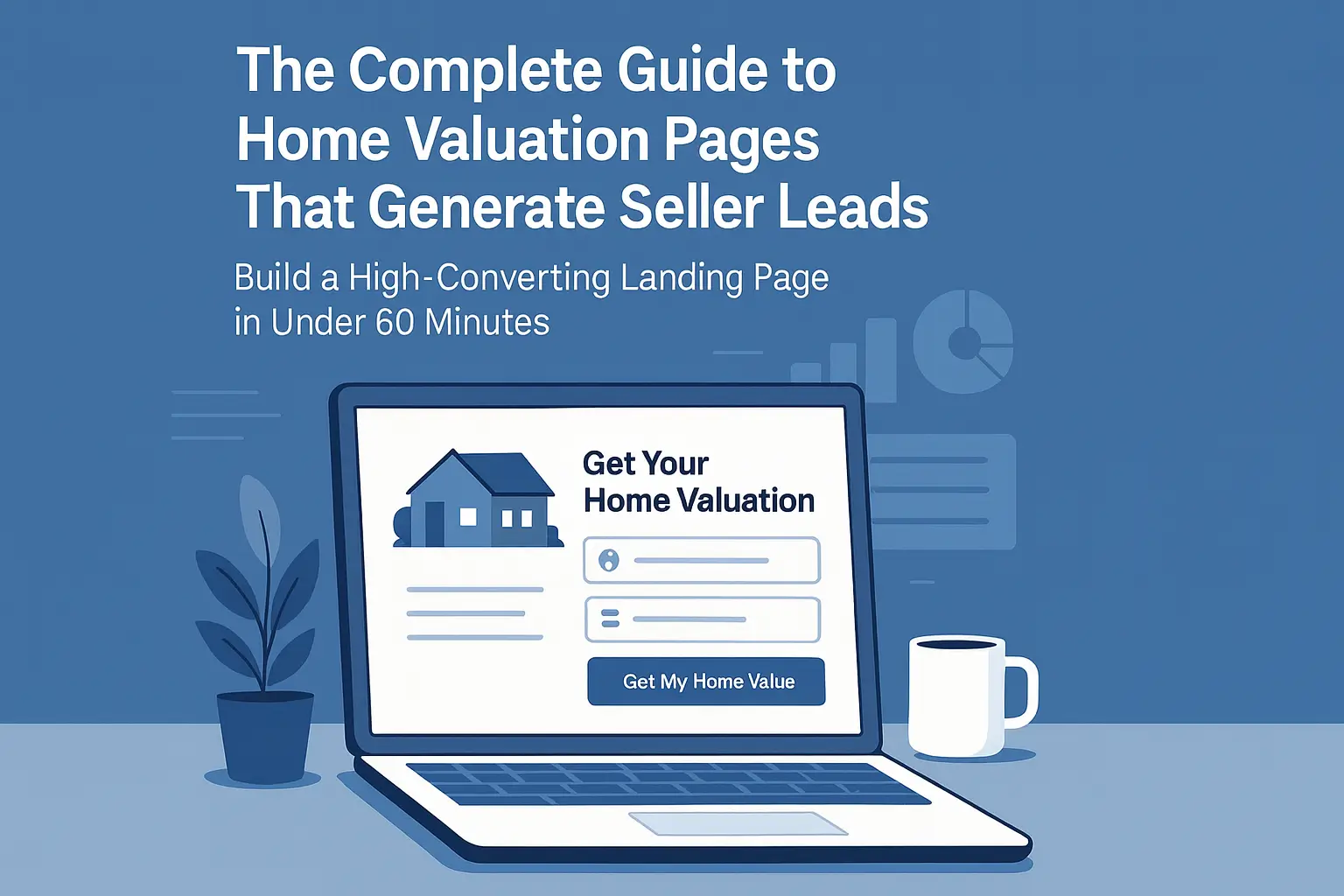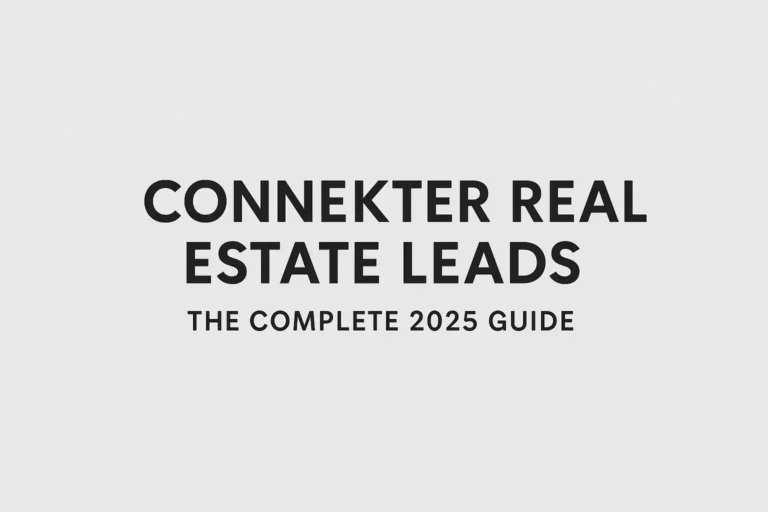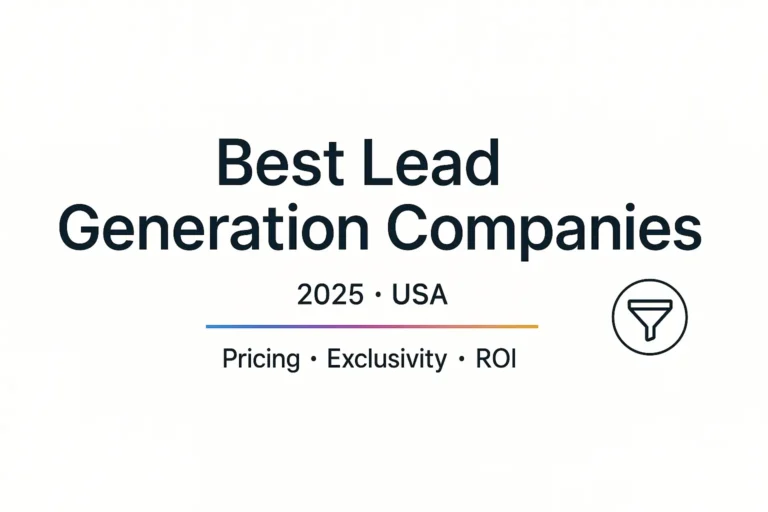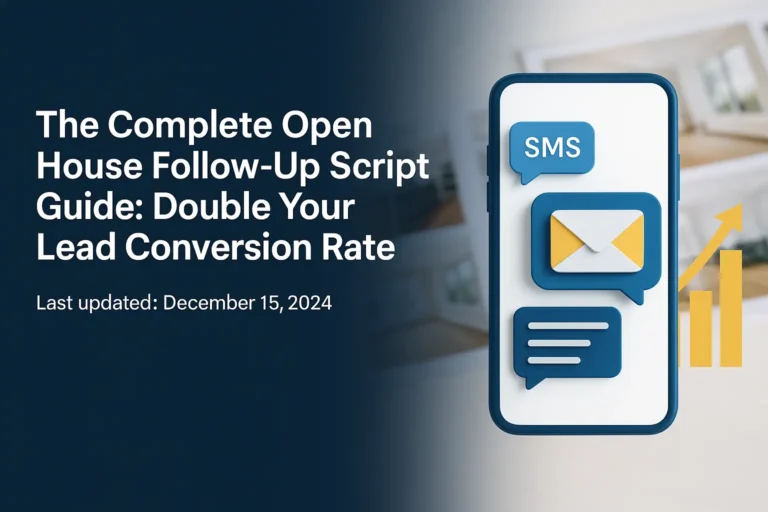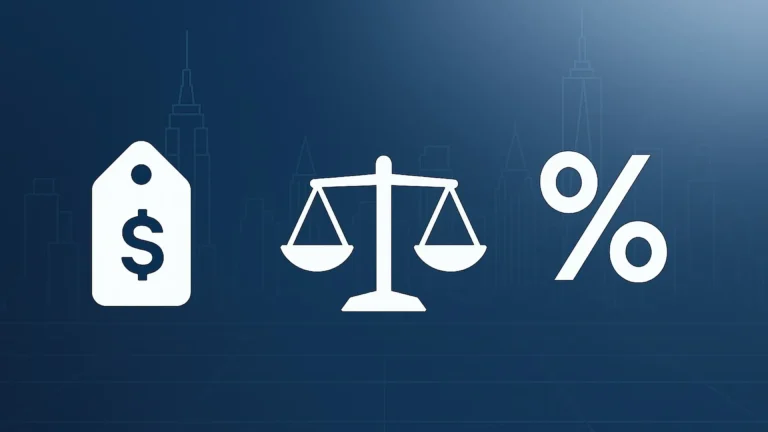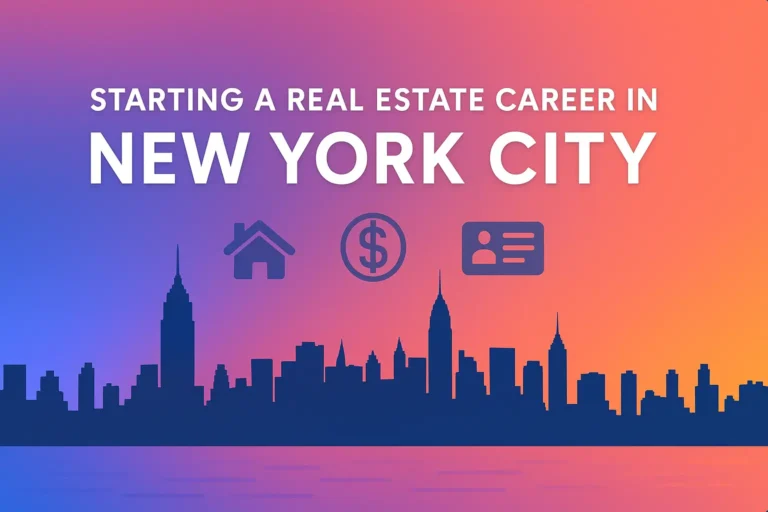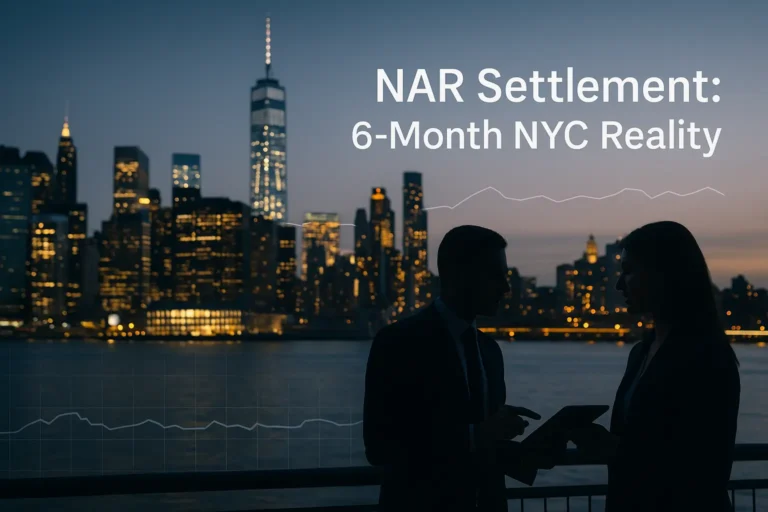The Complete Guide to Home Valuation Pages That Generate Seller Leads: How to Build a Converting Landing Page in Under 60 Minutes
TL;DR: 10 Must-Have Elements for High-Converting Home Valuation Pages
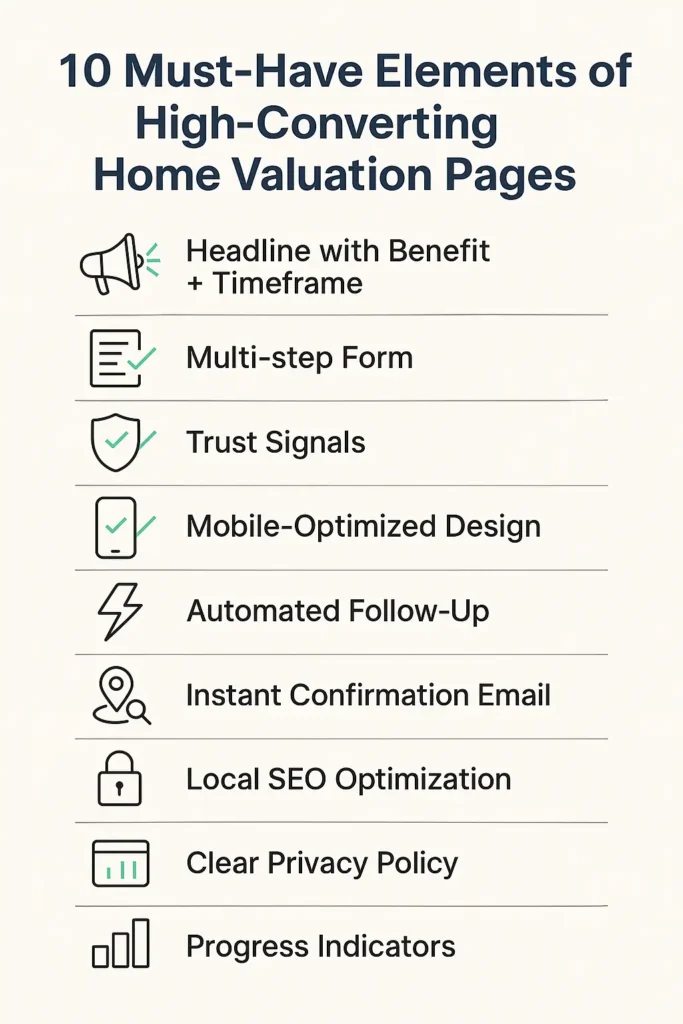
Quick Checklist for Busy Agents & Brokers:
✅ Compelling headline with benefit + timeframe (“Get Your Home Value in 60 Seconds”)
✅ Multi-step form (address → property details → contact info
✅ Trust signals (testimonials, years of experience, privacy guarantees)
✅ Mobile-optimized design with fast loading speeds
✅ Automated follow-up system (Zapier + CRM integration)
✅ Instant confirmation email within 5 minutes
✅ Local SEO optimization for “[city] home value” keywords
✅ Clear privacy policy and data security assurances
✅ Progress indicators for multi-step forms
✅ Tiered value offers (instant estimate + full CMA + consultation)
📈 Expected Results: Well-optimized real estate landing pages convert 7-11% of visitors into leads, compared to just 2% for generic contact forms.
⏱️ Setup Time: 60 minutes using templates and no-code tools
💰 Cost Per Lead: $50-200 typical range 🎯
Lead Quality: 78% of home valuation leads show selling intent within 12 months
Introduction
Picture this: A homeowner sits at their kitchen table, coffee in hand, wondering “What’s my home really worth?” They grab their phone and search for answers. Within seconds, they land on a real estate website that promises an instant, accurate valuation. They enter their address, answer a few quick questions, and hit submit. Fifteen minutes later, they receive a personalized report—and three months later, they list their home with that agent.
This scenario happens thousands of times daily across America. Yet most real estate professionals miss these golden opportunities because their websites lack effective home valuation pages.
Here’s a startling fact: 78% of sellers research home values online before contacting an agent. Even more revealing? Home valuation pages convert 5-15% of visitors into leads—far higher than generic contact forms that struggle to reach 2%.
This comprehensive guide shows you exactly how to build a home valuation page that captures motivated sellers, automates lead nurturing, and transforms your website into a listing-generating machine. You’ll learn proven copywriting formulas, technical setup strategies, and automation workflows that work for both solo agents and large brokerages.
Whether you’re a broker seeking to scale lead generation across multiple agents or a solo practitioner looking to fill your listing pipeline, this guide delivers actionable strategies you can implement today.
Why Home Valuation Pages Outperform Traditional Lead Magnets
The Psychology Behind Seller Motivation
Home valuations tap into fundamental human psychology that drives real estate decisions. Understanding these psychological triggers helps you craft pages that convert browsers into qualified leads.
Immediate Gratification Seekers: Today’s consumers expect instant answers. When homeowners search “what’s my home worth,” they want results now—not after scheduling a consultation. Your valuation page satisfies this need for immediate information while positioning you as the helpful expert.
Low-Risk Exploration: Requesting a home valuation feels safer than scheduling a listing consultation. Homeowners can explore their options without committing to a sales conversation. This lower barrier to entry captures prospects earlier in their decision-making process.
Curiosity-Driven Behavior: Even homeowners not actively planning to sell often wonder about their home’s value. Market fluctuations, neighborhood changes, or simple curiosity drive these searches. Your page captures these “lurkers” who might become serious sellers later.
Urgency Creation: Well-designed valuation pages create subtle urgency through limited-time offers, market condition warnings, or exclusive insights. This psychological pressure encourages immediate action rather than endless research.
Competitive Advantage in Lead Capture
Traditional real estate websites rely on generic contact forms or newsletter signups that produce lukewarm leads. Home valuation pages deliver superior results because they:
Target High-Intent Traffic: Visitors searching for home values show clear selling intent, even if they’re in early research phases. These prospects convert at much higher rates than general real estate browsers.
Provide Immediate Value: Unlike contact forms that ask for information without giving anything back, valuation pages offer valuable insights in exchange for contact details. This value-first approach builds trust and reduces form abandonment.
Enable Personalized Follow-up: The property information collected allows for highly targeted follow-up communications. You can reference specific neighborhoods, comparable sales, and market conditions relevant to their exact situation.
Create Natural Conversation Starters: Follow-up becomes easy when you can lead with their property’s valuation, recent neighborhood sales, or market insights specific to their area.
Essential Elements of High-Converting Home Valuation Pages
Compelling Headlines That Stop the Scroll
Your headline determines whether visitors engage with your page or bounce within seconds. Effective headlines combine curiosity, benefit, and urgency to compel action.
Proven Formula: Problem + Solution + Timeframe + Risk Reversal
Examples that convert:
- “Discover Your Home’s True Market Value in 60 Seconds—Free, No Obligation”
- “What’s Your Home Worth Today? Get an Expert Analysis—Zero Cost, Zero Pressure”
- “Thinking of Selling? Get Your Accurate Home Valuation Before You List”
Power Words That Increase Engagement:
- Instant, Immediate, Quick, Fast
- Accurate, Precise, Expert, Professional
- Free, No Cost, No Obligation
- Exclusive, Personalized, Custom
- Discover, Reveal, Uncover
Trust-Building Elements That Overcome Skepticism
Homeowners hesitate to share personal information online. Your page must address common concerns and build credibility quickly.
Professional Credibility Indicators:
- Years of experience in specific markets
- Professional certifications and designations
- Recent sales volume and client testimonials
- Awards and recognition from industry organizations
Social Proof That Converts:
- “Over 1,200+ homeowners have received their valuations”
- Recent client testimonials with photos
- Google reviews and star ratings
- Local media mentions or quotes
Privacy and Security Assurances:
- Clear privacy policy links
- SSL security badges
- “We never share your information” statements
- Explanation of how data will be used
Form Design That Maximizes Completion
Form design directly impacts conversion rates. The right approach balances information collection with user experience.
Multi-Step Form Strategy: Break information requests into digestible steps:
Step 1: Property address only Step 2: Basic property details (bedrooms, bathrooms, square footage) Step 3: Contact information and preferred communication method
This progressive approach reduces psychological friction and increases completion rates by 20-40%.
Gamification Elements That Boost Completions:
- Progress bars: “You’re 70% done!” creates momentum to finish
- Interactive sliders: Let users adjust property details with visual controls
- Step counters: “Step 2 of 3” shows clear progress
- Completion rewards: “Almost there! Your home value report is being prepared…”
Smart Field Selection: Only request essential information initially:
- Property address (required)
- Email address (required)
- Phone number (optional but recommended)
- Preferred contact method
- Best time to contact
Tiered Value Offers for Different Intent Levels:
Instead of one generic CTA, offer multiple options to capture prospects at various stages:
- “Get Instant Estimate” (automated valuation tool – captures browsers)
- “Request Full CMA Report” (agent-prepared analysis – warm leads)
- “Schedule Valuation Consultation” (personal meeting – hot leads)
This tiered approach can increase total conversions by 25-35% by reducing barriers for cautious prospects while identifying your most motivated leads.
Form Optimization Tactics:
- Use autofill for address fields
- Include field labels inside input boxes
- Add progress indicators for multi-step forms
- Provide clear error messages
- Optimize for mobile completion
Copywriting Frameworks That Convert Browsers into Leads
The AIDA-R Formula for Real Estate
Adapt the classic AIDA formula with a real estate-specific twist that addresses seller motivations and concerns.
Attention: Grab focus with compelling headlines and opening statements “The average home in [Your City] has increased $47,000 in value this year alone.”
Interest: Build engagement with relevant benefits “Discover if your home has gained equity like your neighbors’ properties—and whether now is the optimal time to sell.”
Desire: Create urgency and emotional connection “Don’t miss out on peak market conditions. Get your personalized valuation before prices plateau.”
Action: Clear, compelling call-to-action “Get Your Free Home Valuation Now”
Reassurance: Address final objections “100% free, no obligation. We respect your privacy and never share your information.”
Overcoming Common Seller Objections
Your copy must proactively address concerns that prevent form completion:
“I’m not ready to sell yet” Copy solution: “Not ready to sell? No problem. Many homeowners request valuations simply to understand their equity position and make informed financial decisions.”
“I don’t want to be contacted by pushy salespeople” Copy solution: “We’re here to help, not hassle. Receive your valuation report first, then decide if you’d like to discuss your options—completely pressure-free.”
“Online valuations aren’t accurate” Copy solution: “Our expert analysis goes beyond automated tools. We review recent comparable sales, current market conditions, and unique property features to provide accurate, personalized valuations.”
Emotional Triggers That Drive Action
Financial Motivation: Appeal to equity growth and market timing “Your home may be worth significantly more than you think. Recent sales in your neighborhood show surprising price increases.”
FOMO (Fear of Missing Out): Create subtle urgency without pressure “Market conditions are optimal for sellers right now. Get your valuation while buyer demand remains strong.”
Curiosity Satisfaction: Promise interesting insights “Discover what buyers are really paying for homes like yours—the results might surprise you.”
Technical Setup: Building Your Page in 60 Minutes
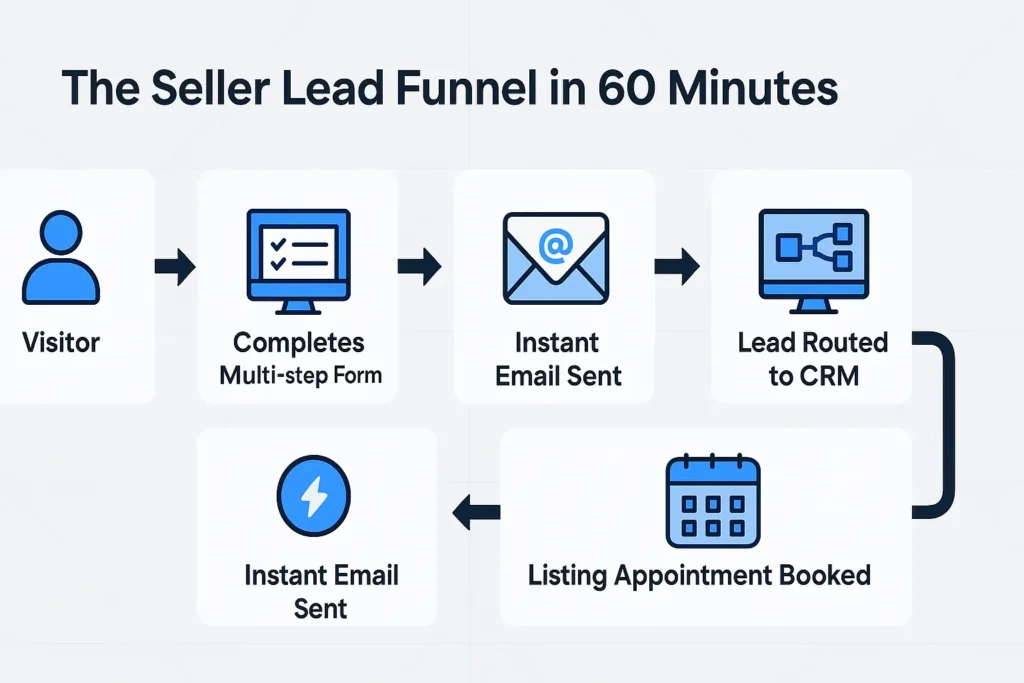
Platform Selection Criteria
Choose a platform based on your technical comfort level, integration needs, and budget constraints.
No-Code Solutions for Quick Launch:
- Unbounce: Professional landing pages with built-in A/B testing
- Leadpages: Real estate templates and CRM integrations
- ClickFunnels: Complete funnel building with email automation
- Instapage: Advanced personalization and analytics
WordPress Solutions for Flexibility:
- Elementor Pro: Drag-and-drop page building with form widgets
- Beaver Builder: User-friendly interface with conversion optimization
- Divi: All-in-one theme with landing page capabilities
Website Builder Add-ons:
- Wix: Built-in forms with CRM integration
- Squarespace: Professional templates with lead capture
- Weebly: Simple setup with automation options
Mobile Optimization Requirements
Over 60% of home valuation searches happen on mobile devices. Your page must perform flawlessly across all screen sizes.
Mobile-First Design Principles:
- Single-column layouts for easy scrolling
- Large, finger-friendly form fields and buttons
- Compressed images for fast loading
- Simplified navigation and minimal distractions
Loading Speed Optimization:
- Compress all images to under 100KB
- Minimize plugins and third-party scripts
- Use browser caching and CDN services
- Test page speed with Google PageSpeed Insights
Form Usability on Mobile:
- Use HTML5 input types for better mobile keyboards
- Implement autofill capabilities
- Minimize required typing with dropdown menus
- Test form completion on various devices
Automation Workflows That Scale Your Lead Generation
Zapier Integration Strategies
Automation ensures no leads fall through cracks while providing immediate value to prospects.
Essential Automation Sequence:
- Instant Confirmation: Send immediate thank-you message with expected delivery timeframe
- Lead Distribution: Route leads to appropriate agents based on location or criteria
- CRM Integration: Automatically add contacts with relevant tags and notes
- Task Creation: Generate follow-up tasks and reminders for agents
- Drip Campaign Enrollment: Add leads to nurturing sequences based on their responses
Advanced Automation Ideas:
- Send market reports specific to the lead’s neighborhood
- Trigger different follow-up sequences based on property value ranges
- Create calendar booking links for qualified prospects
- Generate comparative market analysis reports automatically
CRM Integration Best Practices
Seamless CRM integration transforms raw leads into organized, actionable opportunities.
Lead Scoring Implementation:
- Assign higher scores to leads with higher property values
- Weight recent form submissions more heavily
- Consider geographic location and market conditions
- Factor in engagement with follow-up communications
Contact Organization Strategies:
- Tag leads with property types and locations
- Create custom fields for valuation details
- Set up automated lead distribution rules
- Implement lead lifecycle stages
Email and SMS Follow-up Sequences
Automated communication maintains engagement while you prepare personalized responses.
Immediate Response Template (within 5 minutes): “Thanks for requesting your home valuation! I’m preparing your personalized report and will have it ready within [timeframe]. In the meantime, here’s what makes our analysis different…”
24-Hour Follow-up Template: “Your home valuation is attached! Based on current market conditions in [neighborhood], I’ve included additional insights that might interest you…”
Weekly Nurture Sequence:
- Week 1: Market trends affecting property values
- Week 2: Home improvement tips that increase value
- Week 3: Success stories from recent clients
- Week 4: Seasonal market insights and timing considerations
Why Your Home Valuation Page Beats Zillow and National Portals
The Agent Advantage Over Automated Platforms
While Zillow’s Zestimate and similar tools dominate search results, agent-owned valuation pages offer superior accuracy and personalized service that converts better for serious sellers.
Where Portals Fall Short:
- Generic algorithms can’t assess property condition, upgrades, or unique features
- No local market expertise about neighborhood trends and buyer preferences
- Zero personal follow-up – sellers receive estimates with no expert guidance
- Delayed data – MLS updates lag behind actual market conditions
- One-size-fits-all approach ignores local market nuances
Your Competitive Advantages:
- Personalized analysis considering property improvements and condition
- Real-time market knowledge from recent showings and buyer feedback
- Neighborhood expertise about school districts, development plans, and local amenities
- Professional follow-up with strategic selling advice and market timing guidance
- Relationship building that leads to referrals and repeat business
Positioning Your Page Against Portals:
- “Get a more accurate valuation than Zestimate – we consider factors automated tools miss”
- “Beyond the algorithm: discover what buyers really pay in your neighborhood”
- “Local expertise Zillow can’t provide – backed by [X] years selling homes in [area]”
Driving Quality Traffic to Your Valuation Page
SEO Optimization for Property Value Keywords
Organic search drives the highest-quality traffic to valuation pages because visitors actively seek property information.
Primary Keyword Targets:
- “What’s my home worth” + [city name]
- “Home value estimate” + [neighborhood]
- “House value calculator” + [area]
- “Property valuation” + [location]
- “Home price check” + [ZIP code]
- “Property worth estimator” + [market area]
Long-Tail Keyword Opportunities:
- “Best home valuation tool for [city]”
- “How accurate is [local agent name] home valuation”
- “Free house appraisal estimate [neighborhood]”
- “Compare home values [area] vs Zillow”
Content Optimization Strategies:
- Include location-specific keywords throughout page copy
- Add schema markup for real estate businesses
- Create location-based landing pages for different markets
- Build backlinks from local business directories
Local SEO Enhancement:
- Optimize Google My Business profile with valuation page links
- Encourage client reviews mentioning property valuations
- Create neighborhood-specific content and landing pages
- Partner with local businesses for cross-promotion opportunities
Paid Advertising That Converts
Strategic paid advertising amplifies your reach and targets high-intent prospects.
Google Ads Campaign Structure:
- Campaign 1: Exact match keywords (“home value estimate [city]”)
- Campaign 2: Broad match keywords with negative keywords
- Campaign 3: Remarketing to website visitors who didn’t convert
Facebook and Instagram Ad Strategies:
- Target homeowners in specific ZIP codes
- Use demographic data to identify likely sellers (age, income, home ownership duration)
- Create lookalike audiences based on past clients
- Test video ads showing valuation process or market insights
Ad Copy That Drives Clicks: Headlines: “Curious About Your Home’s Value?” Description: “Get a free, accurate estimate in 60 seconds. No obligation, complete privacy guaranteed.” CTA: “Get My Home Value”
Social Media and Content Marketing
Consistent content marketing establishes authority and drives organic traffic to your valuation page.
Content Ideas That Attract Sellers:
- Monthly market reports with average home values
- Before/after home improvement impact on values
- Neighborhood spotlight features
- Market timing advice and seasonal trends
Social Media Promotion Tactics:
- Share client success stories (with permission)
- Post about recent sales and market conditions
- Create polls asking about market perceptions
- Go live to discuss current market conditions
Advanced Conversion Optimization Techniques
A/B Testing Elements That Matter
Continuous testing improves conversion rates and lead quality over time.
High-Impact Testing Areas:
- Headlines and subheadlines
- Form length and field requirements
- Call-to-action button colors and text
- Trust signals placement and content
- Mobile vs. desktop layouts
Testing Best Practices:
- Test one element at a time for clear results
- Run tests for statistical significance (typically 2-4 weeks)
- Document results and winning variations
- Implement winning changes before testing new elements
Personalization Strategies
Personalized experiences increase conversion rates and improve lead quality.
Dynamic Content Options:
- Show different headlines based on traffic source
- Display location-specific market information
- Customize follow-up sequences based on property values
- Offer relevant content based on visitor behavior
Geographic Personalization:
- Auto-detect visitor location for relevant content
- Show neighborhood-specific testimonials
- Display local market statistics and trends
- Include area-specific contact information
Psychology-Based Design Elements
Subtle design choices influence visitor behavior and conversion decisions.
Color Psychology Applications:
- Blue conveys trust and professionalism
- Green suggests growth and financial success
- Orange creates urgency without aggression
- White space reduces cognitive load
Visual Hierarchy Techniques:
- Use contrasting colors for call-to-action buttons
- Implement the F-pattern layout for natural eye movement
- Place important elements above the fold
- Create clear visual paths to conversion points
Measuring Success: KPIs and Analytics That Matter
Essential Metrics to Track
Monitor key performance indicators that directly impact your lead generation success.
Conversion Metrics:
- Page conversion rate (visitors to leads)
- Form completion rate by step
- Cost per lead by traffic source
- Lead-to-appointment conversion rate
Quality Metrics:
- Lead response rate to follow-up
- Average property value of leads
- Geographic distribution of leads
- Time from lead to listing agreement
Technical Performance:
- Page loading speed
- Mobile vs. desktop performance
- Bounce rate by traffic source
- User behavior flow through the page
Tools for Comprehensive Analytics
Implement tracking systems that provide actionable insights for optimization.
Google Analytics 4 Setup:
- Create conversion goals for form submissions
- Set up enhanced ecommerce tracking
- Implement audience segments for lead quality analysis
- Track user journeys from first visit to conversion
Heat Mapping and User Behavior:
- Hotjar: See where users click and scroll
- Crazy Egg: Analyze user interaction patterns
- FullStory: Watch actual user sessions
- Lucky Orange: Real-time visitor behavior
Lead Quality Analysis:
- Track lead source and conversion rates
- Monitor follow-up response rates
- Analyze appointment booking rates
- Calculate lifetime value by traffic source
Common Mistakes That Kill Conversions
Technical Issues That Destroy Trust
Avoid these critical errors that immediately damage credibility and conversion potential.
Form Problems That Frustrate Users:
- Requiring too much information upfront
- Creating forms that don’t work on mobile devices
- Failing to provide error messages for incorrect entries
- Not including progress indicators on multi-step forms
Page Performance Issues:
- Slow loading speeds (over 3 seconds)
- Broken links or missing images
- Poor mobile responsiveness
- Lack of SSL security certificates
Copy and Design Mistakes
Credibility-Damaging Copy Errors:
- Making unrealistic promises about accuracy
- Using pushy or sales-heavy language
- Failing to address common objections
- Not explaining the valuation process
Design Elements That Reduce Conversions:
- Cluttered layouts with too many distractions
- Unclear or weak call-to-action buttons
- Missing trust signals and social proof
- Poor color contrast affecting readability
Follow-up Failures That Waste Leads
Response Time Issues:
- Delayed initial responses (over 24 hours)
- Generic, non-personalized follow-up messages
- Failing to provide promised valuation reports
- Not maintaining consistent communication
Lead Nurturing Problems:
- Immediately pushing for listing appointments
- Sending irrelevant or generic market information
- Not segmenting leads based on their interests
- Abandoning leads who don’t respond immediately
Future-Proofing Your Home Valuation Strategy
Emerging Technology Integration
Stay ahead of competition by incorporating new technologies that enhance user experience.
AI and Machine Learning Applications:
- Automated property feature detection from photos
- Predictive analytics for optimal selling timing
- Chatbot integration for instant responses
- Dynamic pricing models based on market conditions
Virtual and Augmented Reality:
- Virtual property tours integrated with valuations
- AR tools for visualizing property improvements
- 360-degree neighborhood showcases
- Virtual staging to show property potential
Regulatory and Privacy Considerations
Stay compliant with evolving data protection and real estate regulations.
Data Privacy Requirements:
- CCPA compliance for California residents
- GDPR considerations for international visitors
- Clear consent mechanisms for data collection
- Secure data storage and transmission practices
Real Estate Industry Changes:
- MLS data usage restrictions
- NAR policy updates affecting lead generation
- State-specific real estate advertising regulations
- Fair housing compliance in digital marketing
Frequently Asked Questions
What’s the best home valuation tool for real estate agents?
The best valuation tool combines automated data with professional expertise. Top platforms include:
For Automated Integration:
- HouseCanary: API integration for instant estimates with confidence scores
- RealtyMole: Affordable API with rental value estimates
- CoreLogic: Professional-grade data with detailed comparables
For Agent-Prepared Reports:
- Cloud CMA: Professional presentation tools with market statistics
- W+R Studios: Branded CMA reports with customization options
- Top Producer: Integrated CRM with valuation report generation
The most effective approach combines automated estimates for instant gratification with professional analysis for accuracy and relationship building.
How do home valuation pages compare to Zillow/Zestimate accuracy?
Agent-prepared valuations significantly outperform automated estimates:
Accuracy Comparison:
- Zestimate accuracy: Within 20% of sale price for 67% of properties
- Professional CMA accuracy: Within 10% of sale price for 85% of properties
- Combined approach: Agent-verified automated estimates achieve 90%+ accuracy
Why Agent Valuations Win:
- Account for property condition and improvements
- Consider pending sales and market momentum
- Factor in buyer demand patterns and pricing strategies
- Include neighborhood expertise and development impacts
How accurate are online home valuations compared to professional appraisals?
Online valuations provide helpful estimates but shouldn’t replace professional appraisals or CMAs. Automated tools typically have accuracy rates of 70-80% within 20% of actual sale prices. They use public records, tax assessments, and recent sales but can’t account for property condition, upgrades, or unique features.
Professional agents provide more accurate valuations by considering these factors plus current market conditions and buyer preferences. Industry data shows agent-prepared CMAs achieve 85% accuracy within 10% of sale prices, compared to 67% for automated tools within 20% margins.
What’s the ideal response time for home valuation leads?
Research shows that contacting leads within 5 minutes increases conversion rates by 900% compared to waiting 30 minutes. For home valuation leads specifically, aim for:
- Automated confirmation: Immediately
- Personal follow-up: Within 1 hour
- Complete valuation report: Within 24 hours
- Phone contact attempt: Within 2 hours
Fast response times demonstrate professionalism and capture leads before competitors contact them.
How do I price my services when offering free home valuations?
Free valuations are marketing investments, not profit centers. Calculate your cost per lead and conversion rates to determine ROI. Most agents spend $50-200 per valuation lead and convert 10-20% into listings. If your average commission is $8,000, acquiring a listing for $200 in marketing costs provides excellent returns.
Consider the free valuation as the first step in your sales process, not a standalone service.
What legal considerations apply to home valuation pages?
Key legal requirements include:
- Clear privacy policy explaining data usage
- Disclaimer stating estimates aren’t professional appraisals
- Compliance with state real estate advertising regulations
- Fair housing compliance in all marketing materials
- Proper licensing disclosures where required
Consult with a real estate attorney familiar with your state’s regulations to ensure full compliance.
How do I handle leads who receive low valuations?
Low valuations present opportunities rather than problems. Strategies include:
- Explaining factors that might increase value (improvements, staging, marketing)
- Discussing market timing and seasonal variations
- Offering services beyond selling (refinancing advice, property management)
- Providing renovation guidance to increase value
- Building long-term relationships for future opportunities
Remember that today’s low-value property might be tomorrow’s perfect listing after improvements or market changes.
Should I integrate my valuation page with IDX/MLS data?
IDX integration can enhance credibility by showing recent sales data, but it’s not required for effective valuation pages. Benefits include:
- Displaying comparable sales automatically
- Showing current market inventory
- Providing neighborhood statistics
However, IDX integration adds complexity and cost. Start with a simple, converting page, then add IDX features once you’re generating consistent leads.
How do I compete with Zillow and other national platforms?
Compete through personalization and local expertise rather than technology. Your advantages include:
- Deep local market knowledge
- Personalized follow-up and service
- Ability to view properties in person
- Relationships with local vendors and services
- Flexibility in marketing and pricing strategies
Position yourself as the local expert who provides more accurate, personalized valuations than automated platforms.
The Build → Automate → Optimize Framework
Your 3-Step Success System
Step 1: Build (Week 1)
- Launch your basic valuation page using proven templates
- Set up essential automation for lead capture and follow-up
- Test all forms and integrations on mobile and desktop
- Create initial follow-up email sequences
Step 2: Automate (Week 2-3)
- Implement advanced Zapier workflows for lead routing
- Set up retargeting campaigns for non-converting visitors
- Create automated nurture sequences based on lead behavior
- Integrate with your CRM for seamless lead management
Step 3: Optimize (Ongoing)
- A/B test headlines, forms, and call-to-action buttons
- Analyze conversion data to identify improvement opportunities
- Refine automation based on lead quality and response rates
- Scale successful elements across multiple markets or agents
Conclusion: Launch Your Lead-Generating Home Valuation Page Today
Home valuation pages represent one of the most effective lead generation strategies available to real estate professionals today. By combining compelling copy, user-friendly design, and smart automation, you can create a system that consistently delivers high-quality seller leads while you focus on serving clients.
The strategies in this guide work for solo agents and large brokerages alike. Start with the basic framework, test and optimize based on your results, then scale successful elements across multiple markets or team members.
Your 60-Minute Action Plan:
- Choose your platform and set up the basic page structure (20 minutes)
- Write compelling copy using the templates provided (15 minutes)
- Create and test your lead capture form (10 minutes)
- Set up basic automation for lead notification and follow-up (15 minutes)
Remember: Perfect is the enemy of good. Launch your valuation page quickly, then improve it based on real user behavior and conversion data. The agents who succeed in today’s market are those who take action fast and optimize continuously.
Your next listing client might be searching for their home’s value right now. Give them a reason to choose you by offering immediate value, demonstrating expertise, and making it easy to take the next step.
Start building your home valuation page today, and transform your website from a digital brochure into a powerful lead generation machine that works 24/7 to grow your business.

